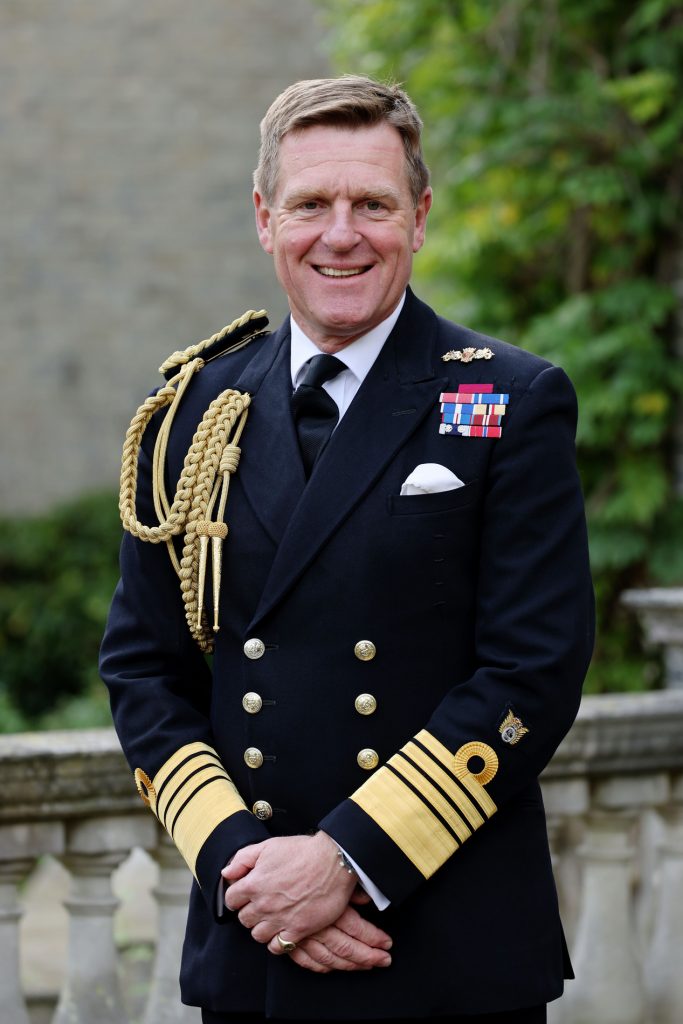
“We face an increasingly unstable global picture
and an increased risk of state-on-state contest.”
By
Admiral Sir Ben Key
First Sea Lord and Chief of Naval Staff (Royal Navy)
As First Sea Lord I am delighted to have been asked to provide my thoughts as we celebrate the excellent bonds between the Marine Nationale and the Royal Navy. In the past eighteen months we have seen the tenth anniversary of the Lancaster House Agreements (1), the realisation of the CJEF (Combined Joint Expeditionary Force) concept where French and UK armed forces work as one, and last summer the dual carrier operations with FS Charles de Gaulle and HMS Queen Elizabeth working together in the Atlantic and Mediterranean (2).
The close operating posture between our two navies reflects the shared values of our two nations: outward looking, maritime democracies who understand the importance of the maritime, and the role we have to play in securing safety, security and prosperity across the globe. We belong to a very small group of carrier navies, and an even smaller band of those capable of deploying globally, from littoral ships to nuclear submarines. We are two navies investing in technology, comfortable with innovation. From command platforms, to hypersonic weapons, we know that deterrence requires time and investment.
The Government’s recent Defence Review, Global Britain in a Competitive Age, highlighted just how our political leaders envisage the United Kingdom’s armed forces: more global, more active, and more persistently deployed. And notably this review sees our Armed Forces: Navy, Army, Air Force and Strategic Command operating much more closely with our key allies and partners across the globe. The review also highlighted the nature of the challenges we face: an increasingly unstable global picture and an increased risk of state-on-state contest, which of course we are seeing now manifesting with Russia’s activity in Ukraine.
Importantly, the Review sets out the rationale for the need for modernisation of our Armed Forces. Opponents who have not stood still, and the proliferation of technology among both state and non-state actors. For this reason the Royal Navy has, over the last few years, seen a renewed investment in the maritime. We have a Government which appreciates the choice, options and flexibility that navies can offer. We are returning to a maritime era. We have seen the unveiling of a sustainable shipbuilding strategy which will provide the frigates, destroyers, littoral response ships and hunter-killer and ballistic missile submarines which we will need into the 2030s.
But we also have to understand the scale of the challenge: the transition from Type-23 to Type-26 and Type-31 frigates, operationalising the Commando Force as the Royal Marines return to their commando roots, operating two carriers at the same time as we deploy the Littoral Response Groups. Central to all of this, for both our security and that of our NATO allies, is the transition from the Vanguard- to Dreadnought-class nuclear deterrent submarines.
These platforms will come in over the next decade, but we have to get the steps right now, to ensure each waypoint on the journey is plotted, as we ensure that first Dreadnought-class submarine sailing on patrol is a success. The risk is, if we do not adopt these changes successfully, we will lose our operational advantage. The threat is setting the pace. Russia is modernizing its navy and upgrading its frigates, amphibious ships and submarine force very quickly. China is building its armed forces at an astonishing rate and deploying them around the world: be that their Navy, their Maritime Militia or their Coast Guard. In this context, standing still is not an option, because standing still risks operational obsolescence. Instead we need to modernise, to exercise, and be ready to operate with our allies and partners around the world who share our outlook.
This global outlook is one that France and the United Kingdom share along with our global interests: from Europe to the Middle East to the Indo-Pacific. Our navies share common interests in the Indo-Pacific, the powerhouse of the global recovery from the pandemic. Both are addressing areas of mutual concern from the proliferation of technology among non-state actors, dealing with more assertive state actors, and climate change, a challenge for all nations.
Personally, I very much welcome our shared approach. From examining our shared challenges in the Euro-Atlantic and more widely, to our work together in NATO as HMS Prince of Wales becomes the NATO command ship. And naturally this is reflected in NATO’s Maritime Command, led by French and British vice admirals as Deputy Commander and Commander (3)
This is a relationship built on mutual trust, respect and beliefs. It was telling that the Major General de la Marine (4) was the sole Admiral from a partner Navy in attendance at the First Sea Lord change of command ceremony aboard HMS Victory (5) back in November. And it was fitting that a ship which once symbolised the rivalry between our two navies in the past, became the platform which demonstrates our ever-strengthening mutual support and cooperation in the present.
–
(1) Editor’s note: The London Treaties or Lancaster House Agreements are the two military treaties signed during the Franco-British summit in London, at Lancaster House, by French President Nicolas Sarkozy and UK Prime Minister David Cameron on November 2nd 2010.
(2) Editor’s note: On the occasion of the Gallic Strike exercise organized by France in early June 2021
(3) Editor’s note: VA Didier Piaton and VA Keith Blount
(4) Editor’s note: VAE Stanislas Gourlez de la Motte
(5) Editor’s note: Launched in 1765, HMS Victory (there were six in the Royal Navy), is a 100-gun ship famous for having been Admiral Nelson’s ship during the battle of Trafalgar (October 21, 1805). It is kept as a museum ship in Portsmouth.